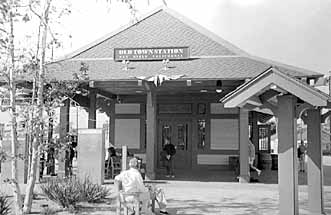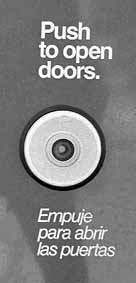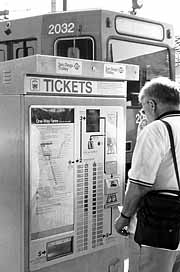![]()
![]()
![]()
![]()
![]()
![]()
![]()

Once you get past a few quirks, the trolley system is a welcome alternative to the car.
by Carolyn Chase
![]() hen I received a jury sum mons notice last
fall, I never thought that I would actually be chosen to serve on a jury.
I figured I'd go downtown one day and be able to check in via phone for
the next four days. Shows what I knew. I was part of the very first group
to be called for the very first trial needing jurors that day. I was one
of the first 24 to be called and darned if I didn't get put on a real live
jury for a civil trial.
hen I received a jury sum mons notice last
fall, I never thought that I would actually be chosen to serve on a jury.
I figured I'd go downtown one day and be able to check in via phone for
the next four days. Shows what I knew. I was part of the very first group
to be called for the very first trial needing jurors that day. I was one
of the first 24 to be called and darned if I didn't get put on a real live
jury for a civil trial.
I was now facing a regular, daily downtown
trip to court with the whopping jury compensation fee of $5 per day plus
mileage. On the parking front, the county lets you know where the closest
lots are ($8 per day) and the cheapest ($3 per day). In between the closest
and the cheapest are both trolley and train station stops. I was determined
that my parking and travel costs not exceed my puny daily stipend. I was
motivated to reduce the cost and stress of a daily drive, the search for
a space and an indeterminate hike. This was my chance to use the trolley
system to commute and be "up close and personal" with local transit.
I'd navigated subways and transit systems around the world. If I could negotiate
the systems in Tokyo, Hong Kong, New York and Washington D.C., surely I
could get with the program here at home.
This wasn't so much an environmental statement
as a personal stress and cost reduction. I think it goes back to the days
when my father was commuting 70 miles each day from L.A. into Orange County
and back again. It was a very high price to pay then. Many years later,
when I commuted to a job in Rancho Bernardo for nearly a year, a key goal
of mine became to always live near where I worked. My personal assessment
is that there is no more vile waste of time than being stuck in traffic,
burning gas and time. So I've generally minimized my personal transportation
costs and stresses by telecommuting that is, working out of my home. But
the environmental advantages to getting out of our cars are formidable as
well.
 Cars do it
Cars do itAutomobiles contribute to air pollution, global
warming and water pollution through their emissions. About 20 percent of
ozone and about one-third of carbon dioxide emissions in the United States
come from the automobile.
Transportation is also a consumer of land.
Hundreds of thousands of acres of wetlands were lost to freeways before
there was a mitigation policy. We continue to lose natural wetlands to freeways
and replace them with constructed wetlands, which science hasn't proven
really work. Transportation also consumes farmland and is a progenitor of
urban sprawl, which takes farmland and open space and leads to more driving,
which leads to more of everything else.
The first key to my downtown transportation
happiness was an arrangement between the county and the trolley system.
Attached to my jury summons was a coupon that could be redeemed for a free
one-way trip on the trolley, worth up to $1.75. Racks in the jury lounge
had all the latest trolley, bus and train schedules.
I'd taken the trolley once before, to the border
and back, but I hadn't ridden the system since it had crept northward toward
my home. First things first: I checked the route map to find the closest
stop to Pacific Beach, in this case the Old Town Station. I checked the
pocket schedule and found that if I arrived at 8:30, I should be able to
park for free, hop a trolley and arrive downtown with plenty of time to
make a 9am court date.
In negotiating any travel system train, subway,
airport, bus station the signs are the most important key to user friendliness
(followed by the station agents and the brochures). Since the purpose of
all these systems is to ease the movement of large numbers of people, they
all have most things in common. It's only the critical details that screw
you up, and this is where the signs can help or hinder.

I have to say that our trolley system is not
the most user-friendly I've experienced. The basic information signs are
large, which is good, but loaded with fine print which is complicated and
bad. When you are rushing to catch a train, you need the basics summarized
simply and easily. Our system could do much better.
On my first day, my first problem was to figure
out: was the train that was sitting in the station the train I wanted? Was
it headed in the right direction?
Being a relatively quick study, it was easy
to figure out that since Old Town is the current end-of-the-line, all trolleys
leaving the station were headed in the right direction. You can usually
look at the end of any transit car and see the destination (or if it's out-of-service).
Confusingly enough, the train in the station
when I arrived said "Old Town." Not very useful. The doors were
closed. Not very inviting. I decided to ask inside the station. It turns
out that the station is not a station per se, but kind of a mini-mart that
didn't open until 9am.
Meanwhile, the train left.
My next lesson was that, unlike every other
system I've ever used where the doors open and close automatically another
indicator of whether or not they are in service the doors on our trolley
system only open when someone presses a button requesting that they open.
Oh well.
 Ticket, please
Ticket, pleaseAnother odd thing about the system is the security.
The system utilizes roving police to regulate access to paid customers.
In other words, anyone can get on or off with or without a ticket. If the
fare police catch you riding without a ticket, you are busted and will pay
a substantial fine. The risk unticketed riders run is based on how often
the system has officers check the trains. In the dozen or so separate trolley
rides I took, I was checked once.
The system has a few other oddities. For instance,
at the 5th and C station they have 3 ticket machines on the south side and
none on the north. This is an unfortunate incentive for jaywalking and undoubtedly
has caused a few folks to miss their train. At Old Town, there is only one
ticket machine for the entire station a major stop on the line. This can
cause lines and delays at key moments when folks just trying to figure out
how to buy a ticket are mixed with those rushing to make their train.
But once I figured out the basics, I loved
it. I now know that the trolley is the best way to get to any county or
city hearings, where even finding parking can be a hassle in addition to
an expense.
Since the end of the trial, I've had occasion
to go downtown a couple of times. When my parking has been subsidized, i.e.,
I'm going to a meeting where the parking bill will be covered, I drove.
When I was running late and not sure of where I was going, I drove. But
just last week I attended a hearing for the Regional Water Quality Control
Board via the trolley. I stopped in at Origami Cafe, had a fabulous lunch
and a short walk to the hearing. On the way back to Old Town, I caught up
on my reading.
The best thing about riding the Trolley was
the leisure and freedom it gave me. While most Southern Californians look
to their cars as the provider of ultimate freedom, I had a much more complete
sense of freedom on the trolley. Riding the trolley was relaxing. I was
able to read, think or listen to my walkman. And, it was cheaper: I didn't
have to pay for the gas and wear and tear on my car. I didn't have to pay
for the parking. I did less walking.
So check out the trolley, it's ultimately the
lower hassle, lower cost choice. And catch up on your reading.

![]()
Carolyn Chase is Chairperson of the Waste Management
Advisory Board of the City of San Diego, a board member of San Diego Earth
Day and a member of the Executive Committee of the San Diego Chapter of
the Sierra Club